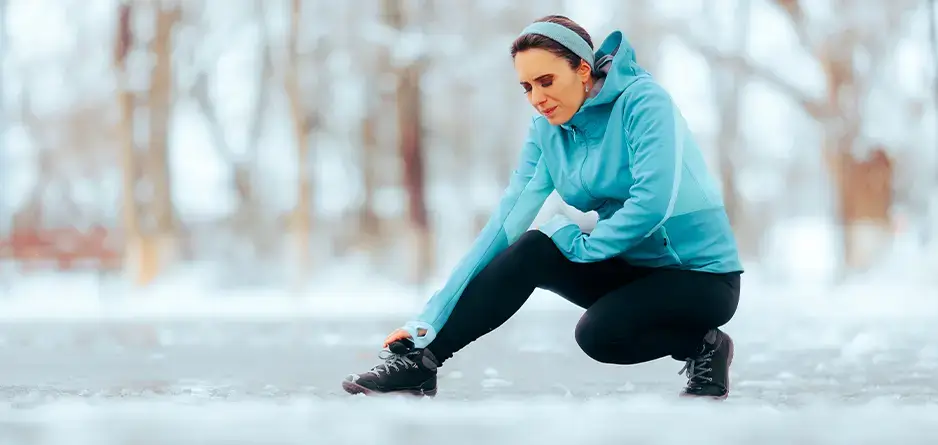Winter and Leg Cramps: Why You Might Feel More Tightness in Cold Weather

Area
Key Takeaways:
- As many as 60% of adults experience leg cramps, particularly in winter.
- Cold weather can narrow blood vessels, reduce blood flow, and cause cramps.
- Crampeze has created 10 strategies for leg cramp relief to add to your daily routine.
Do you often wake up in the middle of a cold winter night with painful leg cramps? These sudden muscle contractions can disrupt sleep and cause unwelcome discomfort. While leg cramps are common year-round, there’s a reason why winter can exacerbate the condition. This article explores the connection between winter and leg cramps, with advice from our experts to help you find effective leg cramp relief.
Understanding Leg Cramps in Winter
Leg cramps, characterised by sudden, involuntary muscle contractions, are a common experience. Up to 60% of adults get leg cramps and many report they get worse in colder months. These cramps, usually felt as intense pain, tightness, or muscle knots in the calf, foot, or thigh, occur when muscle fibres contract forcefully. In winter, this process can be exacerbated as cold temperatures cause vasoconstriction, where blood vessels narrow and reduce blood flow to the muscles, potentially making cramps more frequent and severe.
Why Winter Can Increase Leg Cramps
Chilly winter weather can significantly influence the frequency and intensity of your leg cramps. Let’s take a closer look at why this happens:
- Dehydration: People may feel less thirsty in winter and therefore drink less water, leading to dehydration. Even mild dehydration disrupts muscle function and increases the risk of cramps.
- Reduced Physical Activity: People tend to be less active in winter, leading to muscle stiffness and weakness, which can contribute to cramps.
- Muscle Tension: Shivering and the body’s natural response to cold can cause muscles to tense, making them more prone to cramping.
- Electrolyte Imbalance: Winter diets or reduced intake of fresh foods may affect electrolyte levels. Key minerals like potassium, calcium, and magnesium, crucial for proper muscle function, can become imbalanced.
Learn more about the factors that contribute to cramps and how to support healthy muscle function in this Guide to Leg Cramps.
Symptoms of Winter-Related Leg Cramps
While all leg cramps feel equally uncomfortable, winter can often make these symptoms even worse:
- Nighttime Cramps: You might find yourself waking up more often due to cramps at nighttime.
- Intense Pain: The cramps may feel more severe or sharp.
- Prolonged Tightness: The tightness and soreness after a cramp may last longer than usual.
10 Strategies for Leg Cramp Relief in Winter
Here are ten effective ways to find leg cramp relief, combining soothing techniques with preventive measures:
- Stay Hydrated: Drink plenty of fluids, including warm drinks like herbal tea, even when you don’t feel as thirsty, to maintain proper muscle function.
- Keep Warm: Wear layers of warm clothing, warm socks, and use heat packs or hot water bottles to maintain muscle temperature and promote healthy blood flow.
- Gentle Stretching: When you notice a cramp, stop any activity and gently stretch the cramped muscle. For calf cramps, flex your foot upward. For thigh cramps, pull your ankle backwards towards your body.
- Massage: During a Cramp, firmly massage the affected muscle to increase circulation and help it to relax.
- Heat Therapy: Apply a warm towel, heat pad, or take a warm bath during or after a cramp to soothe tight muscles and improve circulation.
- Regular Movement: Even in winter, try to engage in light activity such as stretching, walking, or yoga to reduce muscle stiffness and enhance circulation.
- Stretch Before Bed: Perform a gentle stretching routine, focusing on your calves, hamstrings, and hip flexors, before going to sleep.
- Proper Warm-Up: Before any cold-weather activity, perform stretches and muscle activation exercises to prepare your muscles for exertion.
- Electrolyte Balance: Ensure your diet includes foods rich in magnesium, potassium, calcium, and sodium. Leafy greens, bananas, nuts, and seeds can help.
- Loosen Bedding: Keep bed sheets and blankets loose around your feet to avoid restricting movement and potential cramping during sleep.
The truth is there’s no magic bullet to cure leg cramps. But by incorporating these simple steps into your routine, you can begin the journey towards healthy, happy, cramp-free muscles.
Multi-Combination Leg Cramp Relief with Crampeze
When you’re looking for real relief from leg cramps, it helps to tackle the problem from all angles. That’s where Crampeze and Crampeze Forte come in.
Unlike other choices on the market, Crampeze offers more than just magnesium, delivering a multi-combination approach to leg cramp relief. Both contain magnesium and antispasmodics like Cramp bark. This special mix can offer targeted relief from cramps, especially during winter.
So, to feel confident you’re on the path to effective relief, explore the Crampeze product collection to find targeted support beyond magnesium alone.
Make this Winter Comfortable and Cramp-Free
Winter can bring more than just chilly weather. For many, it also means an increase in leg cramps. Remember that reduced circulation, dehydration, and muscle tension can all play a role.
Taking proactive steps is key. By staying warm, keeping hydrated, and ensuring you have enough electrolytes, you can minimise your risk.
For those seeking targeted and effective leg cramp relief, consider Crampeze. Don’t let leg cramps disrupt your winter. Explore the Crampeze collection and consult your healthcare professional for more information.
References:
Geelong Medical Group – Possible Reasons Your Legs Cramp at Night
Cleveland Clinic: Vasoconstriction







